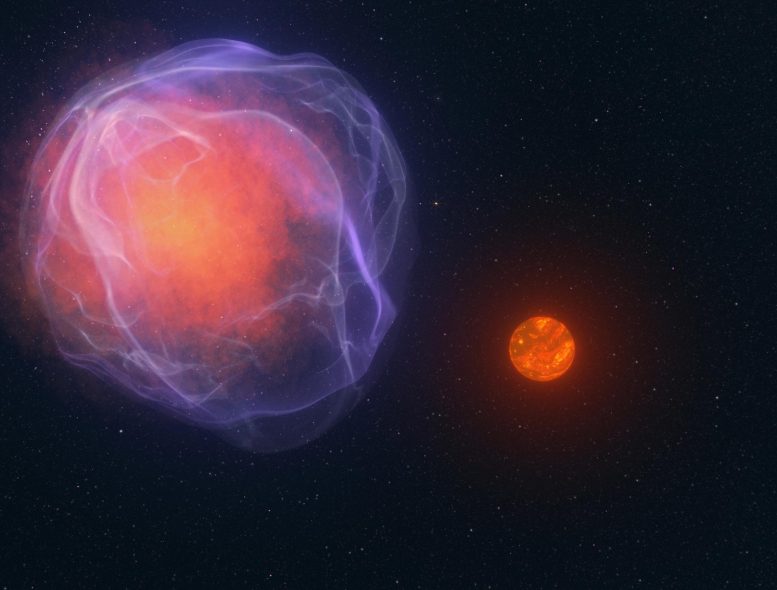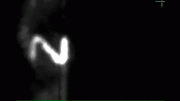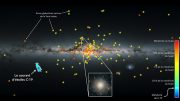
A simulation of a possible explanation for an L subdwarf named CWISE J124909+362116.0’s speed shows it as a part of a white dwarf binary pair that ended with the white dwarf exploding into a supernova. Credit: Adam Makarenko / W.M. Keck Observatory
A newly discovered L subdwarf is on an unusual journey through our galaxy.
The Sun is orbiting the Milky Way at 220 kilometers per second, but an even faster star, J1249+36, has been discovered moving at about 600 kilometers per second. Found by the citizen science project Backyard Worlds: Planet 9, this hypervelocity L subdwarf star could potentially leave the Milky Way.
The Sun’s Motion in the Galaxy
It may seem like the Sun is stationary while the planets in its orbit are moving, but the Sun is actually orbiting around the Milky Way galaxy at an impressive rate of about 220 kilometers per second — almost half a million miles per hour. As fast as that may seem, when a faint red star was discovered crossing the sky at a noticeably quick pace, scientists took notice.
Discovery of a Hypervelocity Star
Thanks to the efforts of a citizen science project called Backyard Worlds: Planet 9 and a team of astronomers from around the country, a rare hypervelocity L subdwarf star has been found racing through the Milky Way. More remarkably, this star may be on a trajectory that causes it to leave the Milky Way altogether. The research, led by University of California San Diego Professor of Astronomy and Astrophysics Adam Burgasser, was presented today at a press conference during the 244th national meeting of the American Astronomical Society (AAS) in Madison, Wisconsin.
The star, charmingly named CWISE J124909+362116.0 (“J1249+36”), was first noticed by some of the over 80,000 citizen science volunteers participating in the Backyard Worlds: Planet 9 project, who comb through enormous reams of data collected over the past 14 years by NASA’s Wide-field Infrared Survey Explorer (WISE) mission. This project capitalizes on the keen ability of humans, who are evolutionarily programmed to look for patterns and spot anomalies in a way that is unmatched by computer technology. Volunteers tag moving objects in data files and when enough volunteers tag the same object, astronomers investigate.
Definitions
Brown dwarf: a class of celestial objects too large to be considered a “gas giant” planet like Jupiter, but too small to power the nuclear fusion of a star.
White dwarf: the dense, compact remnant of a star that has spent all of its nuclear fuel.
Subdwarf: a class of stars that are deficient in elements other than hydrogen or helium, and are typically the oldest stars in the Milky Way.
Analyzing the Star’s Speed and Composition
J1249+36 immediately stood out because of the speed at which it is moving across the sky, initially estimated at about 600 kilometers per second (1.3 million miles per hour). At this speed, the star is fast enough to escape the gravity of the Milky Way, making it a potential “hypervelocity” star.
To better understand the nature of this object, Burgasser turned to the W.M. Keck Observatory in Maunakea, Hawaii to measure its infrared spectrum. These data revealed that the object was a rare L subdwarf — a class of stars with very low mass and temperature. Subdwarfs represent the oldest stars in the Milky Way.
New Atmosphere Models and Findings
The insight into J1249+36’s composition was made possible by a new set of atmosphere models created by UC San Diego alumnus Roman Gerasimov, who worked with UC LEADS scholar Efrain Alvarado III to generate models specifically tuned to study L subdwarfs. “It was exciting to see that our models were able to accurately match the observed spectrum,” said Alvarado, who is presenting his modeling work at the AAS meeting.
The spectral data, along with imaging data from several ground-based telescopes, allowed the team to accurately measure J1249+36’s position and velocity in space, and thereby predict its orbit through the Milky Way. “This is where the source became very interesting, as its speed and trajectory showed that it was moving fast enough to potentially escape the Milky Way,” stated Burgasser.
Did You Know?
At a speed of 220 km/s, it will take the Sun over 200 million years to orbit the Milky Way. This is known as the Sun’s galactic year.
Alumnus Roman Gerasimov, a coauthor on the study, recently received the highly selective International Astronomical Union’s PhD Prize for his work on modeling brown dwarfs in globular clusters.
What Gave This Star a Kick?
Researchers focused on two possible scenarios to explain J1249+36’s unusual trajectory. In the first scenario, J1249+36 was originally the low-mass companion of a white dwarf. White dwarfs are the remnant cores of stars that have depleted their nuclear fuel and died out. When a stellar companion is in a very close orbit with a white dwarf, it can transfer mass, resulting in periodic outbursts called novae. If the white dwarf collects too much mass, it can collapse and explode as a supernova.
“In this kind of supernova, the white dwarf is completely destroyed, so its companion is released and flies off at whatever orbital speed it was originally moving, plus a little bit of a kick from the supernova explosion as well,” said Burgasser. “Our calculations show this scenario works. However, the white dwarf isn’t there anymore and the remnants of the explosion, which likely happened several million years ago, have already dissipated, so we don’t have definitive proof that this is its origin.”
In the second scenario, J1249+36 was originally a member of a globular cluster, a tightly bound cluster of stars, immediately recognizable by its distinct spherical shape. The centers of these clusters are predicted to contain black holes of a wide range of masses. These black holes can also form binaries, and such systems turn out to be great catapults for any stars that happen to wander too close to them.
“When a star encounters a black hole binary, the complex dynamics of this three-body interaction can toss that star right out of the globular cluster,” explained Kyle Kremer, an incoming Assistant Professor in UC San Diego’s Department of Astronomy and Astrophysics. Kremer ran a series of simulations and found that on rare occasions these kinds of interactions can kick a low-mass subdwarf out of a globular cluster and on a trajectory similar to that observed for J1249+36.
“It demonstrates a proof of concept,” said Kremer, “but we don’t actually know what globular cluster this star is from.” Tracing J1249+36 back in time puts it in a very crowded part of the sky that may hide undiscovered clusters.
Future Research and Elemental Composition
To determine whether either of these scenarios, or some other mechanism, can explain J1249+36’s trajectory, Burgasser said the team hopes to look more closely at its elemental composition. For example, when a white dwarf explodes, it creates heavy elements that could have “polluted” the atmosphere of J1249+36 as it was escaping. The stars in globular clusters and satellite galaxies of the Milky Way also have distinct abundance patterns that may reveal the origin of J1249+36.
“We’re essentially looking for a chemical fingerprint that would pinpoint what system this star is from,” said Gerasimov, whose modeling work has enabled him to measure the element abundances of cool stars in several globular clusters, work he is also presenting at the AAS meeting.
Whether J1249+36’s speedy journey was because of a supernova, a chance encounter with a black hole binary, or some other scenario, its discovery provides a new opportunity for astronomers to learn more about the history and dynamics of the Milky Way.









Finding
Searching
Yes Yes
Clusters of mass
The circles of galaxy arms are not magic but I think the force of momentum from space. Gravity connects movement is a force. Baseball flys out of homeplate heads move…
I know silly
3 body
Nuclear force
Black hole vacuum
Astar moving fast…
Why doesn’t the report give the trajectory in relation to the main disc? 14 previous hypervelocity stars have been on or near the main disc axis, suggesting a 3rd, possibly more likely cause relating to our AGN SagA*. Is that data or an image available?
During the AAS 244 Press conference “Stars and Their Antics” where Burgasser presented this object he was asked by the presentation chair if one of the possibilities could be an infall from a merging cluster (or larger star system). He responded that it was unlikely due to the orbit through the disk plane and out, but it was possible – though it would not be an early Andromeda merger star.
@Peter Jackson: Since it is a result from an astronomical conference presentation there is little in the way of peer review publication yet. The talk – which present forward and backward projections of the orbit, if you are interested – refers to a conference poster, not a publication.
Generally, the Sag A* ejection model is now disfavored: “First predicted back in 1988 by Jack Hills, they were originally thought to arise from binary star systems that experienced close encounters with a supermassive black hole. However, a closer examination of the birthplaces of stars revealed two other, more frequent physical causes behind this phenomenon.” “There are two main ways to energetically “kick” a star to great velocities, assuming it originated with a more typical set of parameters for a star within our galaxy.
A cataclysmic event, such as a supernova, kilonova, or gravitational wave-driven merger, occurred in a system where another star was also present, and this star received a kick from this cataclysm.
Or a star experiences a close encounter with a binary (or richer) system, where one of the members is a compact, high-mass object like a black hole, which can impart a high-velocity kick at the expense of leaving the remaining members more tightly bound.” “Remarkably, the idea that all of the hypervelocity stars would come from the galactic center was immediately and severely refuted by the new data. As it turned out, only 15% of the stars are on paths that can be traced back toward or near the center of the Milky Way, whereas 85% of the known hypervelocity stars originate from elsewhere.” “Instead, 55% of hypervelocity stars originated from the galactic disk, but a remarkable 30% appeared to have extragalactic origins: as though they came from a different galaxy than the Milky Way and just happen to be passing through our galaxy’s location right now.” “Conservatively, that means that when the Universe has reached an age of approximately 10^17 years, or around a million times its present age, most galaxies will have already ejected most of their stars and stellar remnants.”[“The Milky Way’s stars are gradually being ejected”, STARTS WITH A BANG — JUNE 12, 2024]
I would add that the star here, despite having a plausible Sag A* ejection scenario, is very old. But the S population of stars orbiting close to Sag A* are young.
“Stars orbiting Sagittarius A* appear ‘rejuvenated’ after devouring other stars” [Earth.com]